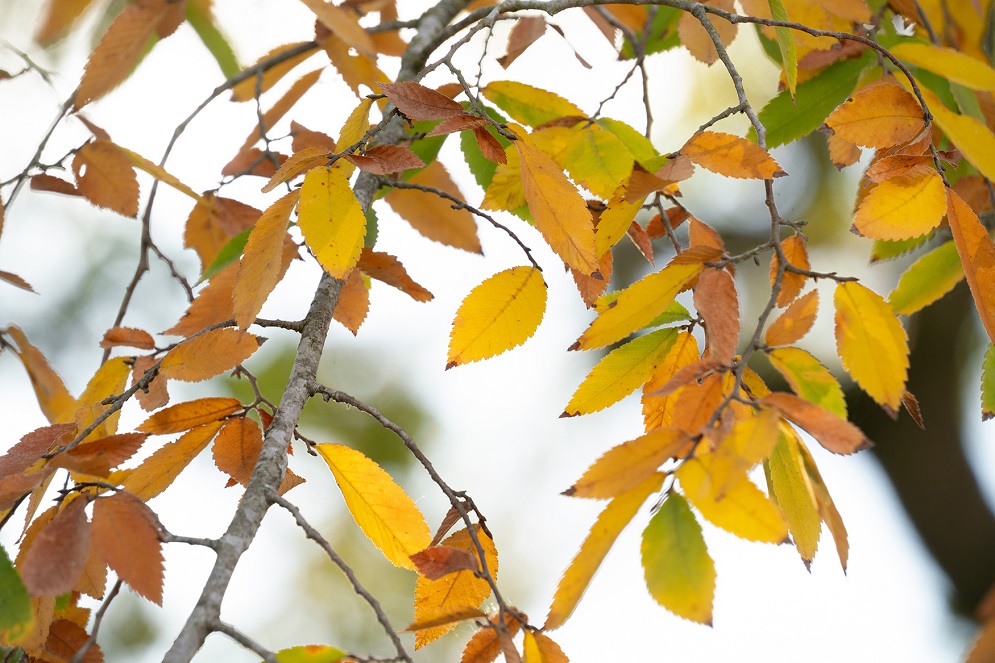November 9, 2025 – COLLEGE STATION, Texas – The transition of trees’ colors from lush green to a variety of warm tones annually marks the changing of seasons, often inducing strong anticipation for a chance to catch a glimpse of the magic.
The chemistry
While fall colors appear as magic to our eyes, it is really a product of color and chemistry.
Trees’ leaves contain pigments that play critical biological roles while also reflecting colors like green, yellow, orange and even brown.
“During a tree’s growing months, chlorophyll dominates the color makeup of the leaf, creating various shades of green,” said Kimberlee Peterson, Texas A&M Forest Service Woodland Ecologist. “Beyond its color and perception to the human eye, chlorophyll is an essential molecule in the photosynthesis process.”
As heat stress or cool temperatures occur, the chlorophyll and green appearance of leaves are destroyed, allowing other pigments to emerge. Although these pigments begin to appear under changes in the environmental conditions, they were present in the leaf all along.
When pigments such as carotenes, xanthophyll and anthocyanin emerge, they often create the notable fall colors of red, orange, yellow, crimson and purple.
Some Texas-native species contain anthocyanin, a key compound in shading chlorophyll later in the growing season to prevent excessive light energy absorption. The formation of this pigment is dependent on an accumulation of carbohydrates in the tree, the genetic properties of the tree and environmental factors.
Texas-native trees containing anthocyanin include sassafras, sweetgum, bigtooth maple, red oak, Tupelo and sumac. The fall colors produced by anthocyanin are often more vibrant because the red pigment is intentionally produced to block sunlight.
Some trees do not contain anthocyanin but instead have carotenoids which are responsible for helping trees absorb light energy for dormancy and protect leaves from sun damage after the photosynthesis process is complete in autumn. They can create red, orange and occasionally yellow pigments in the fall.
Carotene and xanthophyll are subcategories of carotenoids.
Carotenes produce fall colors of red, orange and occasionally yellow. Texas-native trees like black hickory, pecan and elm have contain levels of carotene.
Xanthophyll typically produces yellow and orange pigments; however, red, pink and purple pigments may also develop. Texas-native trees like ash, American beech and river birch contain high levels of xanthophyll.
Timing and conditions
As any fall color enthusiast knows, a tree’s fall colors are never promised—some years they may produce a swatch of perfect mosaic patterns while other years they suddenly drop their leaves with little to no transition.
“Fall colors are nearly unpredictable,” said Peterson. “The destruction of chlorophyll and transition into the emergence of fall pigments closely depends on environmental factors including temperature, light and water. Fall colors can even be influenced by environmental factors from six to nine months prior to fall.”
Where to see fall colors in Texas
While Texas’ fall may not resemble that of an east coast fall, there are still many opportunities to view trees’ chemical magic.
“East Texas is characterized by soft and hardwood trees, which can offer a patchwork of fall colors,” said Peterson. “Central Texas water basins, however, are comprised of bald cypress, cottonwood and sycamore trees, which often display a more unified transition to fall.”
For Texans farther west, Peterson recommends destinations such as the Lost Maples State Natural Area, home to a protected stand of Uvalde bigtooth maples. As of Oct. 31, 2025, Texas Parks and Wildlife Department reported that fall colors will emerge at the Lost Maples State Natural Area soon.
While the rest of the country is at or past its peak fall, Texas’ peak fall foliage remains one of the latest in the nation. The Smoky Mountains Fall Foliage Prediction map provides resources for tracking fall foliage across the country.
###







